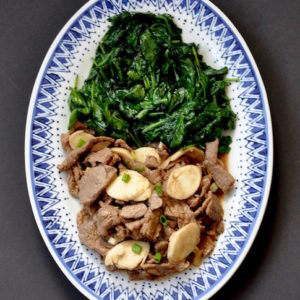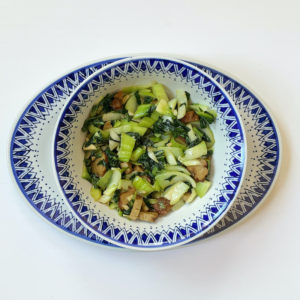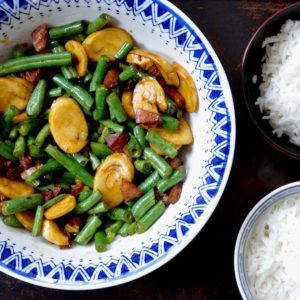Beef stir-fry with leafy greens and rice sticks
Beef stir-fry with leafy greens and rice sticks began as “Beef Slivers With Water Bamboo” from Fuchsia Dunlop’s Revolutionary Chinese Cookbook.

Korean rice sticks, called tteokbokki are stubby, chewy, and completely addictive. I keep mine in the freezer, where they tend to crack. This has no impact on their better qualities.

I used dandelion greens the first time I made beef stir-fry with leafy greens and rice sticks. The result was a chewy dining experience. Bok choy, an altogether gentler green, is a better choice. This said, use whatever green suits your fancy.

Instead of garlic, ginger, and scallions, Dunlop’s recipe calls only for scallions. Who am I to argue?

Her recipe also calls for potato flour, pictured above and below. Cornstarch may be substituted.

We ate our stir-fry with fresh rice noodles, which I buy in sheets and pathetically attempt to prise apart before, during, and after cooking. My skills leave much to be desired. We still enjoy them. Feel free to make this stir-fry with rice or any other noodle.

While the recipe calls for dark and light soy sauces, you can use just one. “Lite” is best avoided, unless you cannot ingest salt for health reasons.

Beef stir-fry with leafy greens and rice sticks makes excellent leftovers. It is especially good cold, eaten directly from the fridge.
Beef Stir-fry with Leafy Greens and Rice Sticks
inspired by Fuchsia Dunlop’s Beef Slivers with Water Bamboo, from Revolutionary Chinese Cookbook
Yield: 2-4 servings with rice or rice noodles
high heat-stable peanut, grapeseed, or canola oil, for the wok
1 pound/500 grams flank steak or other lean beef, sliced very thinly
For the marinade:
1 teaspoon dark soy sauce
2 teaspoons light soy sauce (not low sodium)
1 tablespoon potato starch (cornstarch may be substituted)
1 tablespoon Shaoxing rice wine (use dry sherry in a pinch)
1 tablespoon water
For the rest of the stir-fry:
One bunch bok choy, baby bok choy, or other Chinese greens (water spinach, choy sum, chrysanthemum, or your favorite greens), washed and trimmed into small pieces (about 16 ounces/1 pound/500 grams)
2 scallions, trimmed and sliced
four ounces/1/2 cup/100 grams Korean rice sticks (tteokbokki)
Additional Shaoxing rice wine, if necessary, to add during stir-frying
sesame oil and salt, for seasoning the final dish
Note: I found it helpful to use two large cutting boards while prepping: one for slicing the raw beef and the other for the vegetables.
You will need a large wok–ideally 14 inches–or comparable sturdy frying pan to make this stir-fry.
If you are making rice noodles to accompany the stir-fry, cook them now.
Make the marinade:
In a large glass or ceramic bowl, fork together the soy sauces, potato starch, rice wine, and water. Add the sliced steak and mix well; I find my clean hands do the best job, but use a fork if you prefer. Set aside.
If you are making rice, do it now.
Place wok over high heat and add about 3 tablespoons peanut oil; the bottom of the wok should be generously coated. Heat to just under smoking point.
Carefully add bok choy, scallions, and rice sticks to the wok; getting spattered by hot oil is not a pleasant way to start dinner. Turn heat down a bit: you want heat high enough to cook the food but not so high it burns. Stir constantly, keeping food moving rapdily; rice sticks in particular like sticking. Greens will cook down rapidly. If the wok begins going dry, stand back and pour in a little rice wine.
After a minute or two–the greens will be cooked down and reduced in volume–tip in the beef and its marinade (there won’t be much). It will be a tight fit in the wok. That’s okay. Add a bit of wine if necessary. Keep stirring until the beef is cooked through, about four minutes. Taste for salt. Add sesame oil to taste.
Serve with noodles or rice. I like chili oil at the table with this, too.
Beef stir-fry with leafy greens and rice sticks will keep, refrigerated in a covered container, for about four days. While you could freeze this, it’s inadvisable, as flavor and texture will suffer.
Note: Korean rice sticks are increasingly available in well-stocked supermarkets. They are sold in large plastic bags. Look for them in the frozen foods aisles. Asian markets carry huge varieties of rice cakes in a number of shapes and sizes. They keep in the refrigerater about two weeks and freeze indefinitely.





